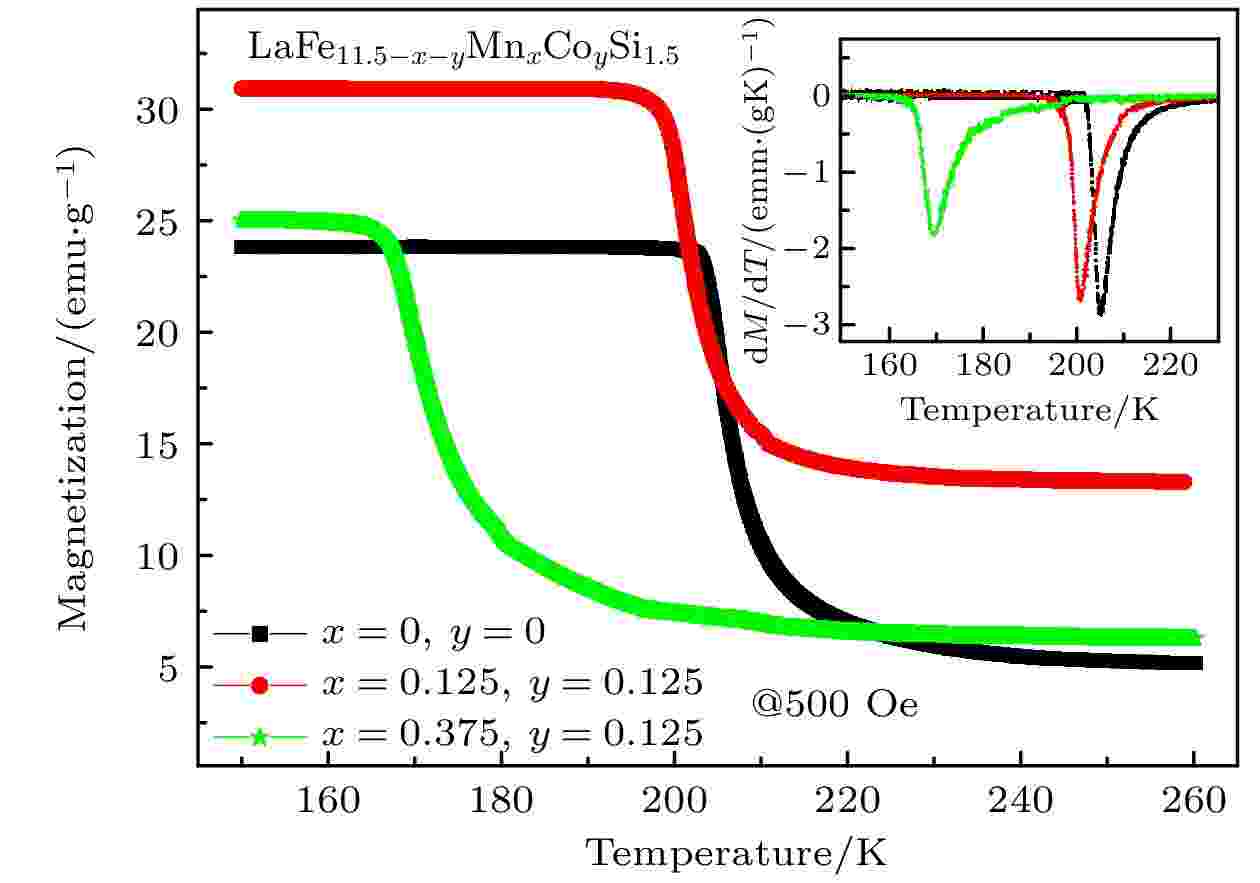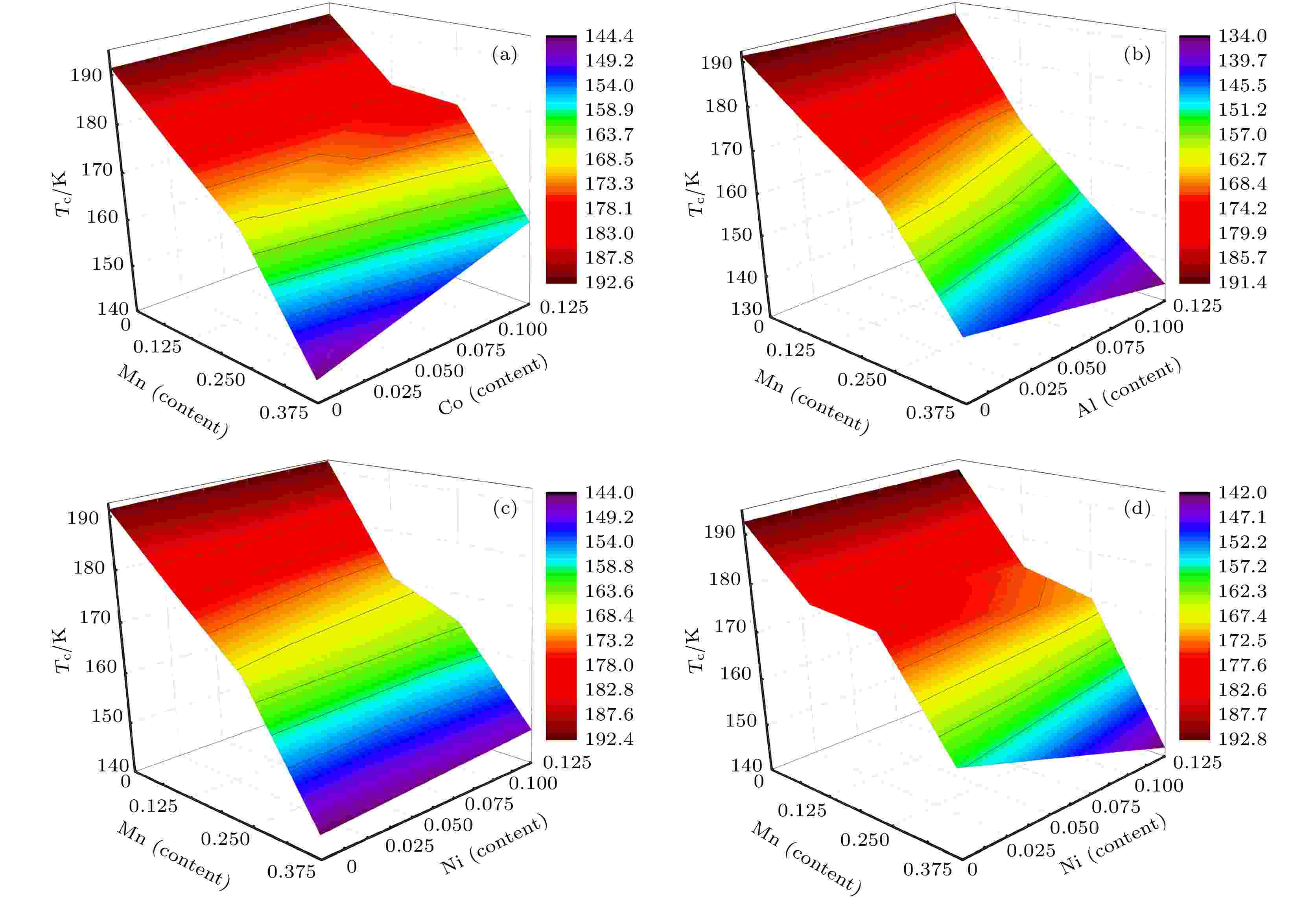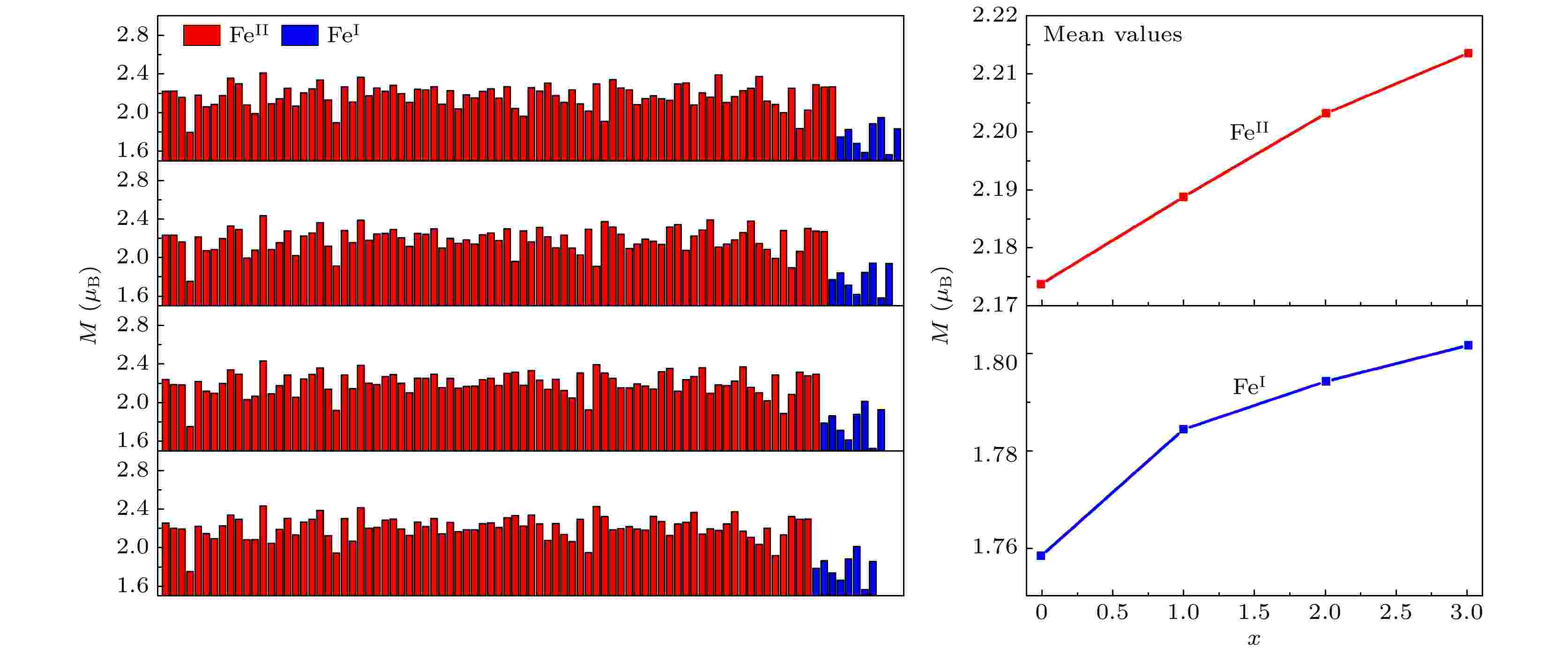全文HTML
--> --> -->通常用磁热效应来衡量材料的磁制冷性能. 磁热效应是指外磁场变化引起磁性材料内部磁熵改变并伴随着吸热和放热的一种物理现象, 是磁性材料的固有特性, 通常用绝热温变和等温磁熵变表征[1]. 高性能磁制冷材料的探索最初是从金属Gd开始的, 其居里温度为294 K, 是一类二级磁相变材料. 1976年, 美国国家航空航天局的 Brown[2]首次采用金属 Gd 作为磁制冷工质, 在7 T的超导磁场和无热负荷的条件下获得了47 K的温度差. 为了拓宽其制冷温区, 多个课题组在Gd基合金中开展了磁制冷的研究工作[3-5]. 1997年, Gschneidner和Pecharsky[6,7]在Gd的三元合金Gd-Si-Ge中获得了巨大的室温磁热效应, 其中Gd5Si2Ge2的最大磁热效应可达Gd最大值的两倍, 是一种具有巨磁热效应的一级磁相变材料. 由于一级磁相变材料明显具有较大的磁制冷效应, 随后越来越多的研究工作都聚焦在探索具有大磁热效应的一级磁相变合金材料中, 并陆续发现了La(Fe, Si)13合金[8,9], Mn-Fe-P-As[10], Ni-Mn基铁磁形状记忆合金[11,12]以及

作为一种典型的一级磁相变材料, La(Fe, Si)13基合金只在相变温度处表现出大的磁熵变, 所以工作区间仅集中在相变点附近较窄的温区, 给实际应用带来了困难. 通过提高外加磁场强度的方法可以起到拓宽磁制冷温区的效果, 但目前磁制冷机普遍采用永磁体, 其提供的磁场强度有限. 为了能在更宽的温度范围内获得大的磁热效应, 目前的磁制冷机大都采用在磁回热器热交换流体流动的方向填充多组具有不同相变温度的磁制冷工质, 希望通过多层工质叠加形成的复叠结构来拓宽制冷温区[14]. 美国宇航公司搭建的原型磁制冷机中使用了6 层La-Fe-Si-H 作为复叠制冷工质, 其磁相变温度较均匀地分布在30.5—40.3 K之间[15], 零负载时系统最大温跨达到了18 K. 根据文献报道, 利用多层磁工质复叠来进行磁制冷是目前最大制冷量原型机[15]和最高效率原型机[16]的常见技术方案.
基于上述分析, 在具有巨磁熵变的一级磁相变材料中, 调节其磁相变温度以获得不同温区下的大磁熵变是磁制冷的一个重要研究方向. La(Fe,Si)13基稀土磁制冷材料中, Mn的掺入可以提高合金的稳定性, 并且La(Fe, Mn, Si)13H合金的磁相变温度可以达到室温[17]. 掺Co和Ni同样也可以提高磁相变温度. 2002年, 胡凤霞等[18]利用Co替代Fe所获得的LaFe11.2Co0.7Si1.1合金的磁相变温度可以提高到274 K, 最大磁熵可达20.3 J/(kg·K). Moreno等[19]发现, 在LaFe11.6Si1.4合金中掺入不同浓度的Ni可以提高磁相变温度, 但是随着Ni浓度的升高, LaFe11.6–xNixSi1.4由一级相变变为二级相变. 2008年, 沈俊[20]研究了La1–xRxFe11.5Si1.5 (R = Ce, Pr, Nd)化合物的磁相变和磁热效应, 发现稀土R替代La会引起晶格收缩, 使Fe-Fe原子间的交换作用减弱, 但导致R-Fe交换作用增强, 从而提高了磁相变温度.
为了获得不同相变温度的磁制冷材料, 目前所采用的研究模式主要是传统炒菜方式, 即利用不同元素替代的方式去逐一合成这些材料再测量它们的磁相变温度. 这将导致研究成本过高, 效率过低, 不利于高性能磁制冷材料的高效研发. 材料基因技术是近年来兴起的材料研发的新模式, 它借鉴人类基因组计划的理念, 通过高通量的计算、 制备和表征等手段来研究材料的组成和结构等与材料性能间的关系. 这种全新的研究理念能缩短材料研发周期、 降低材料研发成本, 在材料研究领域日益受到高度重视.
本文从材料基因技术出发, 以具有巨磁热效应的La(Fe, Si)13基稀土合金为研究对象, 基于高通量的第一性原理计算, 研究了Co, Mn, Ni和Al等多种元素掺杂对体系磁相变温度的影响并构筑了磁相变温度相图, 预测符合实际应用的合金成分, 为获得具有不同磁相变温度的La(Fe, Si)13基稀土磁制冷材料提供了研究基础.
2.1.计算模型
本文以LaFe11.5Si1.5为例来估算不同元素掺杂对其磁相变温度的影响. 根据文献报道, La(Fe, Si)13基材料是具有立方NaZn13型结构的化合物, 空间群为Fm–3c(Oh6). 为了获得Si的占位信息, 首先分析未掺杂Si时LaFe13体系中每种原子的占位情况: LaFe13体系的每个晶胞中有8个La原子和104个Fe原子, Fe原子分别占据FeI(8b位)和FeII(96i位)两个不同的晶位. 其中, 8个La原子和8个FeI原子形成CsCl结构, 每个La原子被24个FeII原子包围. FeI原子被由12个FeII原子所组成的二十面体包围, 具有面心立方的局域环境. FeII原子被9个最近邻的FeII原子和1个FeI原子所包围. 当掺入Si后, LaFe11.5Si1.5体系中的12个Si原子随机占据FeII原子的位置[21], 晶体结构如图1所示. 图 1 LaFe11.5Si1.5基合金晶体结构示意图
图 1 LaFe11.5Si1.5基合金晶体结构示意图Figure1. Schematic image of the crystal structure of LaFe11.5Si1.5-based alloy.
为解释稀土-过渡族化合物的磁性, Beth[22-27]提出了一种模型: 在Fe, Co和Ni中, 仅有5%甚至更少的3d电子被看作是真正的巡游电子, 其余3d电子仍具有局域性, 在库仑作用下, 以被极化的巡游3d电子为媒介, 局域的3d电子之间产生Ruderman-Kittel-Kasuya-Yosida (RKKY)长程相互作用. La(Fe, Si)13基稀土磁制冷材料的交换作用可以用RKKY机制来描述. 进一步地, 根据海森伯模型[28]和平均场理论, 可以通过公式



2
2.2.实验方法
为了验证磁相变温度的估算结果, 除了与部分文献报道结果相对比外, 还制备了三种合金成分进行了实验研究. 在实验中所用的原材料La, Co, Mn, Fe和Si的纯度均为99.9%, 按LaFe11.5Si1.5, LaFe11.25Mn0.125Co0.125Si1.5和LaFe11Mn0.375Co0.125Si1.5化学配比配料后, 将原材料放入充有高纯氩气的电弧炉中, 反复熔炼以保证合金均匀. 经熔炼所得的铸锭样品封在高真空的石英管中, 在1373 K温度下退火7 d后将样品快速淬入冰水混合物中. 利用美国Quantum Design公司的VersaLab测试了所得样品的热磁曲线. 测量时, 测试模式选择“扫场模式”, 变温速率为1.5 K/min, 所加外场为500 Oe. 样品的热磁曲线如图2所示, 所对应的磁相变温度定义为dM/dT的极值. 图 2 LaFe11.5–x–yMnxCoySi1.5合金热磁曲线; 插图是dM/dT曲线
图 2 LaFe11.5–x–yMnxCoySi1.5合金热磁曲线; 插图是dM/dT曲线Figure2. Thermomagnetic curves of LaFe11.5–x–yMnxCoySi1.5 alloys, inset is the dM/dT.
3.1.LaFe11.5Si1.5合金磁相变温度的估算
首先对具有不同晶格常数的LaFe11.5Si1.5合金体系进行几何优化. 通过拟合E-a曲线可以确定体系能量最低时的晶格常数a0 = 11.453 ?, 这与相应的实验值11.464或11.475 ?[33,34]之间的误差不超过0.2%; 然后对该晶格常数下的体系进行加U几何优化得到最终LaFe11.5Si1.5结构; 最后结合平均场理论估算磁相变温度, 计算体系铁磁态和反铁磁态的单点能. 由于LaFe11.5Si1.5基合金为强关联体系, 因此需要对La-d轨道进行加U处理[35]. 通过对多个U值的测试, 发现当U = 0.39 eV时估算得到的LaFe11.5Si1.5磁相变温度为191.4 K, 与实验报道的183.0—198.0 K[33,34,36]非常接近, 与实验值204.0 K (图2)也仅有6%的误差.2
3.2.Co, Mn, Ni, Al掺杂对LaFe11.5Si1.5基合金体系磁相变温度的影响
基于上述计算参数, 利用高通量第一性原理计算研究了Co, Mn, Ni和Al等元素掺杂以及Fe缺位对LaFe11.5Si1.5合金体系磁相变温度的影响. 首先研究了LaFe11.5–xTx Si1.5 (T = Co, Mn, Ni, Al)等单掺合金体系的磁相变温度. 通过比较掺杂原子分别占据FeI或FeII位时体系的单点能, 发现所有的掺杂元素倾向于占据FeII位. 当用Mn元素替代Fe时, 随着Mn含量的升高, 估算出的磁相变温度随之降低, 与实验趋势相符[37]. 当x为0.125时, 估算得LaFe11.375Mn0.125Si1.5的磁相变温度为179.1 K, 与之前实验报道的具有相似成分的LaFe11.4Mn0.1Si1.5材料的磁相变温度181.0 K接近[37]. 随着Mn含量增加到x = 0.25, 估算LaFe11.25Mn0.25Si1.5的磁相变温度为167.8 K, 非常接近文献报道的实验值168 K[37]. 当单掺杂Co和Ni元素时, 体系的磁相变温度随着掺杂量的增加而升高, 与实验报道的趋势一致[38]. 在利用Ni进行掺杂, 当y取0.125时, 估算得到的LaFe11.375Ni0.125Si1.5的磁相变温度为192.3 K, 接近文献报道的具有相近成分LaFe11.385Ni0.115Si1.5的实验值195.0 K[38].在上述工作的基础上, 研究了多元合金LaFe













 图 3 合金体系相变温度相图 (a) LaFe11.5–x–yMnxCoySi1.5; (b) LaFe11.5–x–yMnxAlySi1.5; (c) LaFe11.5–x–yMnxNiySi1.5; (d) LaFe11.375–x–yMnxNiyCo0.125Si1.5
图 3 合金体系相变温度相图 (a) LaFe11.5–x–yMnxCoySi1.5; (b) LaFe11.5–x–yMnxAlySi1.5; (c) LaFe11.5–x–yMnxNiySi1.5; (d) LaFe11.375–x–yMnxNiyCo0.125Si1.5Figure3. The phase diagrams of phase transition temperature: (a) LaFe11.5–x-yMnxCoySi1.5; (b) LaFe11.5–x–yMnxAlySi1.5; (c) LaFe11.5–x–yMnxNiySi1.5; (d) LaFe11.375–x–yMnxNiyCo0.125Si1.5 alloys.
在LaFe11.5Si1.5合金中同时掺杂Mn和Al原子, 估算LaFe11.5–x–yMnxAlySi1.5体系的磁相变温度并给出了磁相变温度随成分变化的相图. 如图3(b)所示, 随着Al和Mn的掺入, 体系的磁相变温度逐渐降低, 在LaFe11Mn0.375Al0.125Si1.5体系中出现了磁相变温度最低值134.2 K. 紧接着, 研究了LaFe11.5–x–yMnxNiySi1.5合金体系的磁相变温度. 根据如图3(c)所示的成分-磁相变温度相图可以看出, 当Mn含量一定时, Ni的掺入提高了体系的磁相变温度. 而当Ni含量一定时, 体系的磁相变温度则随Mn含量的增加逐渐降低. LaFe11.5–x–yMnxNiySi1.5体系的磁相变温度最高和最低值分别为192.3和144.4 K. 进一步地, 本研究小组研究了Mn, Ni和Co三元共掺体系LaFe11.375–x–yMnxNiyCo0.125Si1.5, 其成分-磁相变温度相图如图3(d)所示. 随着Mn含量的增加, 磁相变温度呈下降趋势; 而随着掺杂Ni含量增加, 体系磁相变温度逐渐升高, 在LaFe11.25Ni0.125Co0.125Si1.5中磁相变温度达到最高值192.8 K.
2
3.3.Fe缺位对LaFe11.5Si1.5基合金体系磁相变温度的影响
元素缺位也是一种有效调控磁相变温度的手段[39,40]. 本研究组研究了Fe缺位对LaFe11.5Si1.5基合金体系磁相变温度的影响. 如前所述, 在LaFe11.5Si1.5中, 每个晶胞中有92个Fe原子, Fe可以占据FeI或FeII位. 当缺失1个Fe原子, 分别对FeI或FeII缺位时体系的能量进行对比, 发现相同缺失浓度下, FeI缺失时体系的能量较低. 所以在下面的计算中, 将FeI位设为Fe的缺失位点. 当不掺杂任何元素, FeI位缺失一个Fe原子时, LaFe11.375Si1.5的磁相变温度为160.0 K, 与LaFe11.5Si1.5的191.4 K相比有所下降. 进一步地, 对FeI位缺失一个Fe原子时多元掺杂合金体系LaFe







 图 4 合金体系相变温度相图 (a) LaFe11.375–x–yMnxNi ySi1.5; (b) LaFe11.375–x–yMnxCoySi1.5; (c) LaFe11.25–x–yMnxNiyCo0.125Si1.5; (d) LaFe11.25–x–yMnxCoyNi0.125Si1.5
图 4 合金体系相变温度相图 (a) LaFe11.375–x–yMnxNi ySi1.5; (b) LaFe11.375–x–yMnxCoySi1.5; (c) LaFe11.25–x–yMnxNiyCo0.125Si1.5; (d) LaFe11.25–x–yMnxCoyNi0.125Si1.5Figure4. The phase diagrams of phase transition temperature: (a) LaFe11.375–x–yMnxNi ySi1.5; (b) LaFe11.375–x–yMnxCoySi1.5; (c) LaFe11.25–x–yMnxNiyCo0.125Si1.5; (d) LaFe11.25–x–yMnxCoyNi0.125Si1.5 alloys.
这样, 通过高通量第一性原理计算的方法估算了Co, Mn, Ni和Al等元素掺杂以及Fe缺位时LaFe11.5Si1.5基合金体系的磁相变温度, 为实验上筛选具有合适磁相变温度的La(Fe, Si)13基磁制冷材料提供了技术支持.
2
3.4.PDOS分析及Fe磁矩变化
磁制冷材料磁矩的大小是影响其磁熵变值的一个重要因素. 为了研究Al, Co, Mn, Ni等元素掺杂对LaFe11.5Si1.5合金体系磁矩的影响, 分别计算了LaFe11.375T0.125Si1.5体系投影态密度(PDOS)和元素掺杂后Fe的磁矩.图5为LaFe11.375T0.125Si1.5体系的PDOS分布. 从图5(a)中可以看出, 当掺入原子Al时, Al自旋向上(正)和自旋向下(负)的PDOS值几乎是对称的, 因此Al没有磁性. Al-p主要在–10—–5 eV, 对PDOS有贡献. 虽然Al-p对体系PDOS的贡献很小, 但是Al-p与Fe-d的PDOS峰一一对应, 表明Al-p与Fe-d有一定的杂化. 在费米能级附近, Fe-d自旋向上电子主要占据价带, Fe-d自旋向下电子几乎均匀分布于价带和导带. Fe-d自旋向上和向下电子PDOS的不对称分布使得FeI和FeII的平均磁矩分别为1.716μB/FeI和2.150μB/FeII, 与计算得出的LaFe11.5Si1.5体系中FeI和FeII的平均磁矩1.758μB/FeI和2.179μB/FeII相比有所减小.
 图 5 LaFe11.5–xTxSi1.5 (T = Al, Co, Mn, Ni)合金体系的PDOS图
图 5 LaFe11.5–xTxSi1.5 (T = Al, Co, Mn, Ni)合金体系的PDOS图Figure5. The PDOS of LaFe11.5–xTxSi1.5 (T = Co, Mn, Ni, Al) alloys.
当掺杂Co原子时, 发现费米能级附近电子自旋向上电子态密度主要分布在价带, 并且PDOS主要由Co-d与Fe-d共同贡献且二者PDOS峰耦合很好; Fe自旋向下电子态密度几乎均匀分布在费米能级两侧的价带和导带, 而Co-d轨道自旋向下PDOS值相对Fe-d向价带方向有明显的移动, 导致Co-d与Fe-d的PDOS耦合较差(图5(b)). Fe-d自旋向上和向下的PDOS值分布明显不对称, 计算得出FeI和FeII的平均磁矩分别为1.758μB/FeI和2.174μB/FeII, 相比于掺Al体系, Co掺杂体系中FeI和FeII的平均磁矩都有所增大, 与LaFe11.5Si1.5体系中FeI和FeII的磁矩几乎一致.
Mn原子掺杂相比于Co和Al的掺杂, 情况有所不同. 如图5(c)所示, Mn-d的PDOS峰相对于Fe-d向右偏移, 并且自旋向上电子态密度最高峰出现在费米能级处, Mn-d与Fe-d耦合较强, 峰值一一对应; 而在能量为–5.00—0.25 eV, Mn-d与Fe-d自旋向下的PDOS杂化增强; 能量高于0.25 eV时, PDOS主要由Mn-d贡献, 且与Fe-d耦合变差. Fe-d自旋向上和向下的PDOS值分布更加不对称, 导致FeI和FeII的平均磁矩分别为1.773μB/FeI和2.188μB/FeII, 与LaFe11.375Co0.125Si1.5相比, 磁矩进一步增加, 相比于LaFe11.5Si1.5体系中FeI和FeII的磁矩1.758μB/FeI和2.179μB/FeII也有所增加. 掺杂Ni时, LaFe11.375Ni0.125Si1.5合金的PDOS分布与掺Co时相似(图5(d)). 相比于Co-d的PDOS分布, 自旋向下Ni-d的PDOS峰明显向左偏移, 导致自旋向上与向下PDOS分布比较对称. Fe-d的PDOS存在明显的不对称分布, 估算LaFe11.375Ni0.125Si1.5合金中Fe的磁矩分别为1.743μB/FeI和2.175μB/FeII, 相比于LaFe11.5Si1.5体系中FeI和FeII的磁矩有所减小.
从上述结果可以得出, 相比于LaFe11.5Si1.5体系, 掺杂Ni和Al时FeI和FeII磁矩稍微减小; 掺杂Co时FeI和FeII磁矩几乎不变, 只有掺入Mn时磁矩才有所增加. 进一步地, 对多元掺杂LaFe11.375–xMnxCo0.125Si1.5合金体系的磁矩进行了计算, 研究了该体系中Fe磁矩随Mn含量增加的变化趋势. 如图6所示, 随着Mn含量增加, 每个FeI和FeII原子的磁矩都受到不同程度的影响, 平均磁矩都有所增加, 由1.758μB/FeI和2.179μB/FeII (x = 0) 分别增加到1.802μB/FeI和2.213μB/FeII (x = 0.375).
 图 6 LaFe11.375–xMnxCo0.125Si1.5合金体系中Fe的磁矩
图 6 LaFe11.375–xMnxCo0.125Si1.5合金体系中Fe的磁矩Figure6. The magnetic moment of Fe atom in LaFe11.375–xMnxCo0.125Si1.5 alloys.
本文的数值计算是在南京大学高性能计算中心的计算机集群上完成的, 感谢南京大学高性能计算中心提供计算平台.
